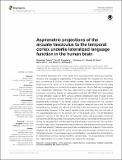Asymmetric projections of the arcuate fasciculus to the temporal cortex underlie lateralized language function in the human brain
Author(s)
Takaya, Shigetoshi; Kuperberg, Gina R.; Liu, Hesheng; Greve, Douglas N.; Makris, Nikos; Stufflebeam, Steven M.; ... Show more Show less
DownloadTakaya-2015-Asymmetric projectio.pdf (1.611Mb)
PUBLISHER_CC
Publisher with Creative Commons License
Creative Commons Attribution
Terms of use
Metadata
Show full item recordAbstract
The arcuate fasciculus (AF) in the human brain has asymmetric structural properties. However, the topographic organization of the asymmetric AF projections to the cortex and its relevance to cortical function remain unclear. Here we mapped the posterior projections of the human AF in the inferior parietal and lateral temporal cortices using surface-based structural connectivity analysis based on diffusion MRI and investigated their hemispheric differences. We then performed the cross-modal comparison with functional connectivity based on resting-state functional MRI (fMRI) and task-related cortical activation based on fMRI using a semantic classification task of single words. Structural connectivity analysis showed that the left AF connecting to Broca's area predominantly projected in the lateral temporal cortex extending from the posterior superior temporal gyrus to the mid part of the superior temporal sulcus and the middle temporal gyrus, whereas the right AF connecting to the right homolog of Broca's area predominantly projected to the inferior parietal cortex extending from the mid part of the supramarginal gyrus to the anterior part of the angular gyrus. The left-lateralized projection regions of the AF in the left temporal cortex had asymmetric functional connectivity with Broca's area, indicating structure-function concordance through the AF. During the language task, left-lateralized cortical activation was observed. Among them, the brain responses in the temporal cortex and Broca's area that were connected through the left-lateralized AF pathway were specifically correlated across subjects. These results suggest that the human left AF, which structurally and functionally connects the mid temporal cortex and Broca's area in asymmetrical fashion, coordinates the cortical activity in these remote cortices during a semantic decision task. The unique feature of the left AF is discussed in the context of the human capacity for language.
Date issued
2015-09Department
Harvard University--MIT Division of Health Sciences and TechnologyJournal
Frontiers in Neuroanatomy
Publisher
Frontiers Research Foundation
Citation
Takaya, Shigetoshi, Gina R. Kuperberg, Hesheng Liu, Douglas N. Greve, Nikos Makris, and Steven M. Stufflebeam. “Asymmetric Projections of the Arcuate Fasciculus to the Temporal Cortex Underlie Lateralized Language Function in the Human Brain.” Frontiers in Neuroanatomy 9 (September 15, 2015).
Version: Final published version
ISSN
1662-5129